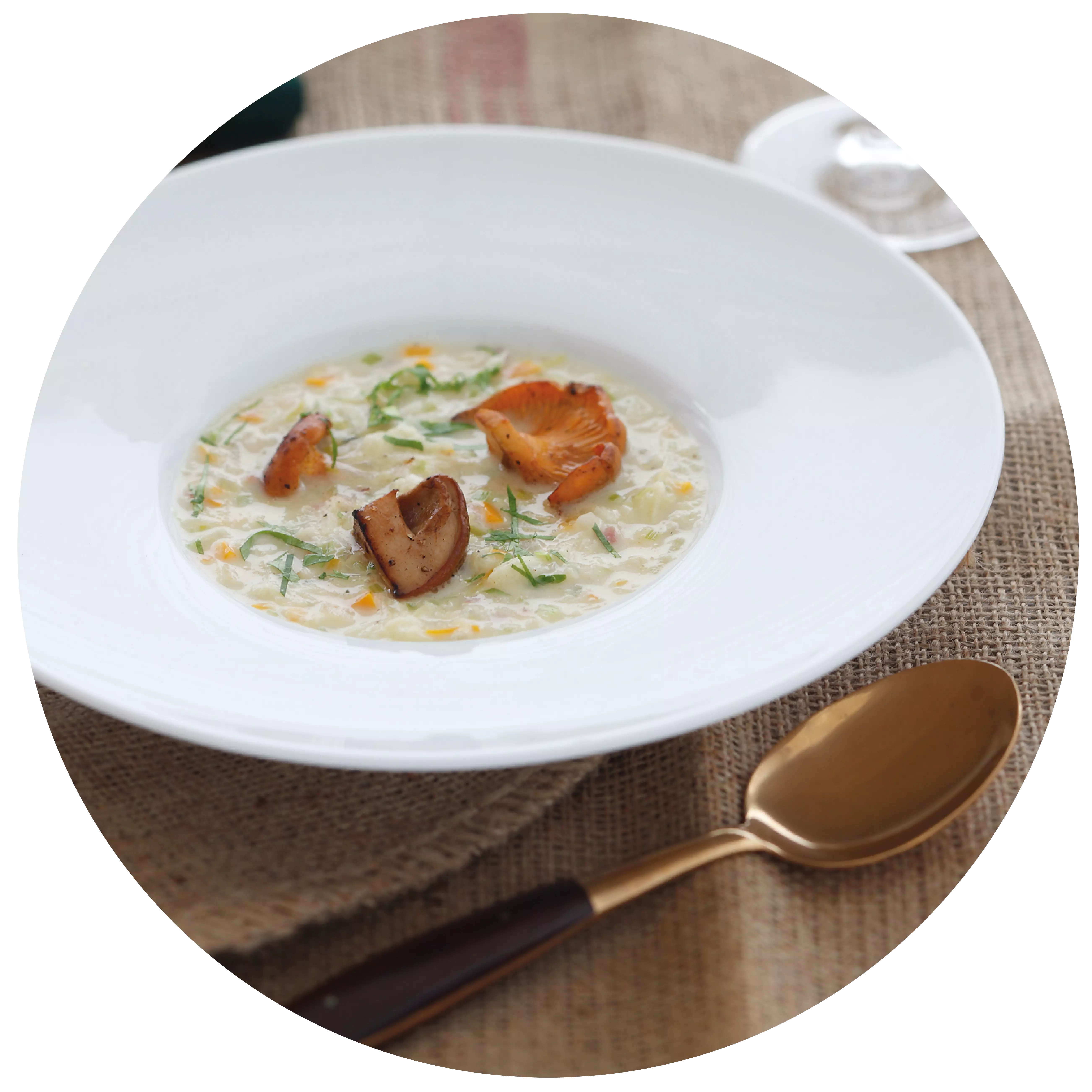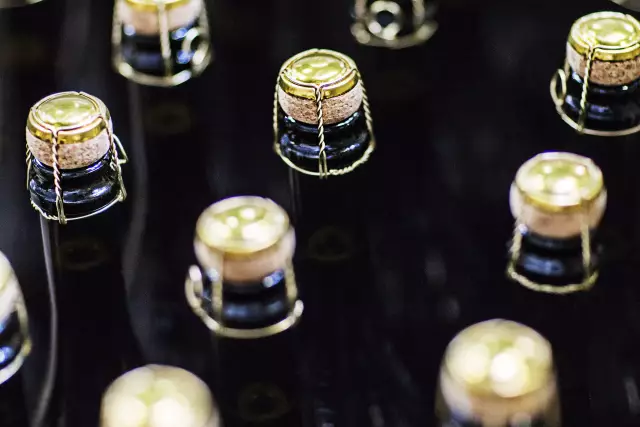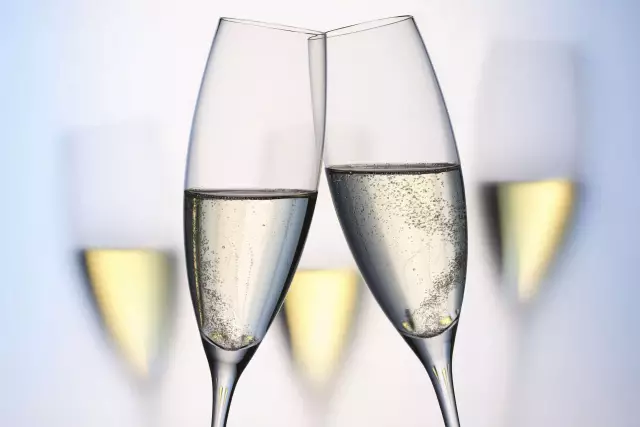Sparkling wine

Be it New Year’s Eve, a party or brunch, a Formula One or a horse race – whenever people are bubbling over with joy, it’s hard to imagine them without a glass of bubbly, the sparkling crown jewel of winemaking.
Facts
-
8 - 10°
are ideal drinking temperatures
-
3,5
bar minimum
-
9 Monate
Fermentation in the bottle
-
0-3g
residual sugar content correspond to "brut nature".
German gourmets are the world champions of Sekt consumption. And that’s why many wine estates have established Winzersekt as a fixed component on their list of offers.
Extra Effort brings Extra Flavor
Classic fermentation in the bottle: At the beginning of the production of Sekt, sugar and a special kind of yeast, able to withstand great pressure, are added to the base wine. This initiates the second fermentation, producing the CO2 that will later make the Sekt sparkle so pleasantly in the glass. The pressure exerted by the carbonic acid needs to amount to at least 3.5 bar – up to 6 bar can be achieved. In the original method of Sekt manufacturing, the so-called Méthode champenoise, and in classic bottle fermentation, the second fermentation takes place in the individual bottle.
In a dark and cool cellar, Winzersekt lies and matures on its yeast for a minimum of 9 months, sometimes for years. After this, the bottles are placed upside down into so-called riddling racks. For a period of four weeks, they get turned daily and set ever more steeply upright at the same time. At the end of this laborious process, all the yeast has collected in the bottle’s neck. The bottle necks are then immersed in a brine (a freezing cold solution) to make the yeast freeze. If the bottles are opened now, the pressure from the carbonic acid ejects the yeast clot. The technical term for this process is “disgorging”.
Since the term “Méthode champenoise” has been exclusively reserved to the products of the French Champagne region for many years, Sekt manufactured by this method in Germany uses the term traditional or classic bottle fermentation.
Designations of styles
The designations for the styles of Sekt as defined by German Wine Law are different from those of wine, because the natural carbonic acid content of Sekt reduces the perception of sweetness. Accordingly, the permissible residual sugar levels of a dry Sekt are markedly higher than those of a dry wine.
- brut nature: 0-3 g/l
- extra brut: 0-6 g/l
- brut: 0-12 g/l
- extra dry: 12-17 g/l
- dry: 17-32 g/l
- semi-dry: 32-50 g/l
- mild: over 50 g/l
Not everything that foams is sparkling wine:
Schaumwein is the generic term for moussing, i.e. foaming wines with perlage, with a minimum pressure of 3 bar.
Sparkling wine is sparkling wine whose carbonic acid is produced during fermentation and generates at least 3.5 bar of internal pressure.
Perlwein has less pressure, the carbonic acid may also be added. Good sparkling wines are fresh, light, summery-fruity and at the same time relatively inexpensive, as they are not subject to sparkling wine tax.
Secco is the modern term for trendy sparkling wines.
Crémant can be called German sparkling wines that meet certain specifications for grape varieties, harvest and fermentation.
Which wine-growing region was the first to introduce sparkling wines to the market?
Rheinhessen launched the first vintner sparkling wines in Germany more than 25 years ago.
Varietals

with wild mushrooms Cream of potato soup
with wild mushrooms
- 300 Gramm geschälte Kartoffeln
- 100 Gramm Wurzelgemüse
- 100 Gramm Waldpilze
- 1 ganze Zwiebel
- 1 ganze Knoblauchzehe
- 30 Gramm Speckwürfel
- 40 Gramm Margarine
- 750 ml Brühe
- 200 ml Sahne
- 1 Zweig Thymian
- nach Belieben Petersilie, Butter, Salz, Pfeffer, Muskat
Clean, wash and finely dice the root vegetables. Finely dice the onion and garlic clove and finely chop the thyme. Sauté the diced bacon with the margarine in a pan until lightly browned, add the diced onion, garlic, root vegetables and thyme. Sauté, add the stock and cook for 2 minutes.
Finely grate the potatoes, add to the soup and cook for a further 5 minutes, add the cream, season and flavour. Clean, wash and chop the mushrooms and sauté in a pan with butter. Season with salt and pepper, sprinkle with chopped parsley and pour over the soup when serving.
- Riesling (trocken)
- Riesling (halbtrocken & feinherb)

with strong red wine Wild boar ragout
with strong red wine
- 800 Gramm Fleisch vom Wildschwein (Keule o. Schulter)
- 80 Gramm Bauchspeck
- 100 Gramm Zwiebeln
- 60 Gramm Karotten
- 60 Gramm Staudensellerie
- 1 TL Tomatenmark
- 200 ml kräftigen Rotwein
- 100 ml Portwein
- 1 Liter braune Wildbrühe
- 1 TL Preiselbeeren
- 1 EL geschlagene Sahne o. Sauerrahm
- 20 Gramm Mehl
- 1 Stück Lorbeerblatt
- je 1 Zweig Rosmarin und Thymian
- 4 zerdrückte Wacholderbeeren
- 1/2 TL Senf
- nach Belieben Salz & Pfeffer
Clean and wash the vegetables and cut into evenly sized cubes.
Remove the fat, skin and tendons from the wild boar meat and cut into 3 cm cubes. Season with salt and pepper and sprinkle with flour. Heat the oil in a frying pan and brown the meat on all sides. Add the vegetables and diced bacon and fry. Add the tomato purée and stir fry. Deglaze with the red wine and port, reduce and pour in the brown game stock. Add the spices to the meat in a small spice bag and leave the ragout to simmer in the oven at 160°C for approx. 1½ hours.
Then remove the pieces of meat, remove the spices, strain the sauce, add the cranberries and mustard and leave to reduce for about 15 minutes. If necessary, thicken with a little cornflour. Serve with the whipped cream.
- Spätburgunder / Pinot Noir (trocken)

with goat's cheese Courgette and chanterelle salad
with goat's cheese
- 2 ganze Zucchini
- 3 EL Rapsöl
- 1 kleine Schalotte
- 300 Gramm Pfifferlinge
- 1 Msp. gemahlener Piment
- 2 Bund Rucola
- je 1/2 Bund Kerbel u. glatte Petersilie
- je 3 EL Walnuss- u. Rapsöl
- 4 Stück Ziegenkäse-Taler
- 1 Prise Zucker
- nach Belieben Salz & Pfeffer
Salad:
Wash the courgettes and slice thinly. Place in a bowl and mix with the oil.
Heat a grill pan and fry the courgettes in batches until golden brown. Season with salt and pepper, place in a bowl.
<p
<p>Peel and finely dice the shallot. Clean the chanterelles, wash if necessary and pat dry. Depending on size, cut in half if necessary.
<p
<p>Sauté the shallot in a pan until translucent. Add the chanterelles and fry vigorously for 3 minutes while stirring. Season with salt, pepper and allspice. Add to the courgettes. Wash the rocket and spin dry.
Dressing:
Wash the herbs, shake dry. Pluck the leaves, blend finely with both types of oil and vinegar in a blender or with a hand blender. Flavour with salt, pepper and sugar. Pour over the courgette and chanterelle mix and mix loosely with the rocket. Arrange on plates, sprinkle with goat's cheese.
- Pinot Blanc (trocken)

with chanterelle and onion leek, served with potato and grilled cheese ragout in grilled tomato Chop of Hunsrück veal
with chanterelle and onion leek, served with potato and grilled cheese ragout in grilled tomato
- 4 x 300 Gramm Kotelettes
- 250 Gramm Pfifferlinge
- 4 große Kartoffeln
- 2 große Grilltomaten
- 180 Gramm Flammkäse
- 50 Gramm Knollensellerie
- 200 ml Spätburgunder
- 200 ml Sahne
- 50 Gramm Butterschmalz
- 2 EL Butter
- 1 EL Rapsöl
- 6 Stück Lauchzwiebeln
- 1 kleine Knoblauchzehe
- je 1 Zweig Thymian & Rosmarin
- je 1 TL Majoran & Oregano
- nach Belieben Salz & Pfeffer
Peel the potatoes, celery and garlic clove, crush the garlic and cut the potatoes and celery into small cubes. Heat the rapeseed oil in a pan, add the potato and celery cubes, sauté briefly and top up with ⅔ of the cream. Season with salt, pepper and the crushed garlic and leave to simmer for approx. 6 minutes. Add the oregano, marjoram,
add a little thyme and the diced flambé cheese and remove from the oven immediately.
Season the veal chops with pepper, fry in the pan in hot clarified butter for approx. 3 to 4 minutes on both sides and then cook in the oven at 160 degrees for 8 to 9 minutes. Then leave the meat to rest briefly.
Cut the grilled tomatoes in half, remove the skin, place on a baking tray and fill with the potato and flambé ragout. Place the baking tray in the oven with the chops for approx. 6 - 7 minutes. Add 1 tbsp of butter and the sprig of rosemary to the roasting mixture, deglaze with the Pinot Noir, reduce a little and refine with the remaining cream. Season to taste with salt and pepper.
Clean the chanterelles and spring onions. Wash the spring onions well, cut into 5 cm pieces, blanch briefly in salted water and rinse in ice water. Heat 1 tbsp butter in a pan, add the chanterelles and sauté for 2 - 3 minutes. Add the spring onions and the rest of the thyme and season with salt and pepper.
<p- Riesling (trocken)









